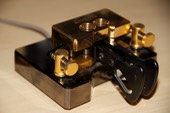Balanced Antenna's
It is important to understand that I have had limited space for
antennas, most of what I use and have used are compromise antennas.
In 2008 I lived in a semi detached house in a residential area, at the rear of the house I had a small garden that measures 25ft x 25ft.
I
can't fit full size beams or dipoles for anything less than the 15m
band. As conditions are not so great I have been playing on 20m and
below, I like the inter G activity on 80m. Due to my space 80m antennas
are going to be 'squashed' into my garden. I have spent quite a bit of
time reading material relating to antenna efficiency. The feed point
for my antenna - is located in the back garden, approximately 50 feet
away from my radio. The feed line runs in between my outside house wall
and my neighbors house wall - with an 8ft gap from house to house. My
antenna's at the moment are homebrew multi band antenna's - either
vertical or dipole styles. As I have limited ability to put out
radials, I tend to favour dipole antennas and I have to be very careful
not to cause RFI to surrounding houses.
From what I can gleam;
Balanced open wire feeder is the most efficient cable and has a much
lower loss than coaxial cable. Loss could also be associated with feed
line radiation. The loss characteristics of the cable are amplified
when there is high SWR. There are several types of open wire feeder
including 450ohm window line and 300ohm ladder line.
Balanced line is not so easy to feed through house walls (as in my case).
Balanced line requires a balanced ATU, for a quality ATU there is
considerable expense, or they require to be matched to the unbalanced
50ohm output of the radio using a balun. Balanced line also influences
impedance and can provide a better operating parameter for the ATU.
There is a lot of material available relating to baluns. From what I
can make out, the typical 4.1 balun will for example take a 200ohm
balanced load and convert it to a 50ohm unbalanced load. Most 4.1
baluns are voltage baluns. The typical 1.1 balun are current baluns,
which take a 50ohm unbalanced load and force it equally into a balanced
load. There would appear merit in both baluns depending on the
impedance of the antenna and your ATU's capabilities. However the 1.1
balun which forces equal current into the balanced line would be the
choice to ensure the balanced line does not radiate prior to the
antenna elements.
A RG213 50ft feed line run, with a .66 velocity factor, using a
non resonant dipole and with SWR factors of 70 plus, I can expect to
loose 70% of my power in feed line loss.
Using a 50ft ladderline run, with a .88 velocity factor, using a non
resonant dipole and with SWR factors of 70 plus, I can expect to loose
30% of my power in feed line loss.
Or; by using 50ft ladderline for every 100watts of power 70watts goes
out the ends of my antenna, vs only 30watts when using coax. And
as balanced feeder line is used it does not resonate - which could
cause potential RFI problems.
Following the above train of thought, I now have approx 15ft of RG213
leaving my radio out through the house wall, then terminated into a 1.1
current balun.
My feedline run from the balun is 37ft, the end of this run then terminates into an additional set length of ladderline (either 10ft or 20ft) to ensure I have a total ladderline feeder length of 1/8 wavelength of the lowest frequency or odd multiple length of 1/8. This is recommended to provide the broadest impedance range to the 1:1 balun.
The center height of the dipole is max 40ft, made possible by using the mast from my tv antenna.
One leg runs south to north dropping down to 4ft above the ground - it backtracks (parallel) along the horizontal ladder line run - but is several feet higher, the other leg runs north to south drops at quite a steep angle to 8ft above ground. I generally run less than 30watts, but am able to go the UK maximum of 400watts, the antenna appears to work on all bands from 80m up. The ATU is a Palstar AT1500DT and the balun is a DX Engineering DXE-BAL050-H10-AT 1.1 current balun.
I am also experimenting with a delta loop - this type of antenna appears to work well, along with occupying a much smaller space...
From direct experience more wire higher up are recipes for HF
success. My home QTH will never allow a dipole antenna for the
80/40/30/20/&
17m bands to be truly balanced as there are too many nearby buildings.
However my antenna will be as efficient as I can make it to provide
best results with minimum power/loss/RFI. This is an on-going
story.............
